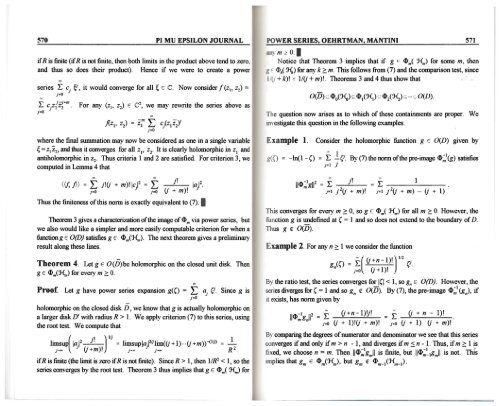Vol. 10 No 7 - Pi Mu Epsilon
Vol. 10 No 7 - Pi Mu Epsilon
Vol. 10 No 7 - Pi Mu Epsilon
You also want an ePaper? Increase the reach of your titles
YUMPU automatically turns print PDFs into web optimized ePapers that Google loves.
570 PI MU EPSILON JOURNAL<br />
if R is finite (if R is not finite. then both limits in the product above tend to zero,<br />
and thus so does their product). Hence if we were to create a power<br />
series L c 1<br />
f/, it would converge for all ~ E C. <strong>No</strong>w consider f (z 1<br />
, z 2<br />
) =<br />
j=O<br />
't"'<br />
j=i+m<br />
~ C .Z 1 Z.2 .<br />
j=O J<br />
For any (z 1 , z 2 )<br />
E C 2 , we may rewrite the series above as<br />
00<br />
j{zl' z2) = z2"' L ciz1 z2Y<br />
j=O<br />
where the final summation may now be considered as one in a single variable<br />
~ =z1 z 2 , and thus it converges for all z., z 2 . It is clearly holomorphic in z 1<br />
and<br />
antiholomorphic in z 2 . Thus criteria 1 and 2 are satisfied. For criterion 3, we<br />
computed in Lemma 4 that<br />
00 00 .,<br />
((f, Ji) = L J!(j + m)! lc) 2 = L J. la) 2 .<br />
j=O j=O (/ + m)!<br />
Thus the finiteness of this norm is exactly equivalent to (7). 1<br />
Theorem 3 gives a characterization of the image of m via power series, but<br />
we also would like a simpler and more easily computable criterion for when a<br />
functiong E O(D) satisfies g E m(}{,). The next theorem gives a preliminary<br />
result along these lines.<br />
Theorem 4. Let g E O(D)be holomorphic on the closed unit disk. Then<br />
g E m(}{,) for every m 2: 0.<br />
00<br />
Proof Let g have power series expansion g( () = L a 1<br />
(i. Since g is<br />
j=O<br />
-<br />
holomorphic on the closed disk D, we know that g is actually holomorphic on<br />
a larger disk D' with radius R > 1. We apply criterion (7) to this series, using<br />
the root test. We compute that<br />
Iimsup( Ia f J! ) 1 /j = Iimsup Ia f'ilim( (j + 1) .. · (j + m) ro(J) - - 1 -<br />
J-"" J (j + m)! J-'" J J-"" R 2<br />
if R is finite (the limit is 7..ero if R is not finite). Since R > I , then 11 R 2 < 1, so the<br />
series converges by the root test. Theorem 3 thus implies that g E m( 1-fm) for<br />
POWER SERIES, OEHRTMAN, MANTINI 571<br />
any m 2 0. 1<br />
<strong>No</strong>tice that Theorem 3 implies that if g F. m< ~~) for some m, then<br />
g '= J ~) for any k 2: m. This follows from (7) and the comparison test, since<br />
1/(j + k)! s 1/(j + m)!. Theorems 3 and 4 thus show that<br />
The question now arises as to which of these containments are proper. We<br />
m,·estigate this question in the following examples.<br />
Example 1.<br />
Consider the holomorphic function g E 0(/J) given by<br />
g(( ) = -ln(1-() = i: ~(i. By (7) the nonn of the pre-image ~,\g) satisfies<br />
j=1 J<br />
1<br />
= !: --------------<br />
1= 1 j 2 (/ + m) .. · (j + 1 )<br />
This converges for every m 2: 0, so g E m( 1-fm) for all m 2: 0. However, the<br />
function g is undefined at (=I and so does not extend to the boundary of D.<br />
Thus g (£ O(D).<br />
Example 2. For any n 2: I we consider the function<br />
(n (<br />
(() = !: (j' + n - 1)') l /2<br />
· (i.<br />
gn j=O (j + 1)!<br />
By the ratio test, the series converges for Kl < 1, so gn E O(D). However, the<br />
series diverges for ( = 1 and so gn (£ O(D). By (7), the pre-image ~ 1<br />
(gn), if<br />
1t exists, has norm given by<br />
-1 ll2 _ i: (j+n-l)!i!<br />
II mgn - . (j 1)1(j )I<br />
;=o + . + m .<br />
"' (i + n - 1)!<br />
(i + 1 ) (j + m)!<br />
~ --------------<br />
By comparing the degrees of numerator and denominator we see that this series<br />
converges if and only if m > n - I, and diverges if m :S n - 1. Thus, if m 2: I is<br />
fixed, we choose n = m. Then 11~ 1 g,ll is finite, but 11~~ 1g,ll is not. This<br />
unplies that g, E ,(1-f,), but g, (£ ,_ 1<br />
(1!,_ 1<br />
).<br />
j=O
















